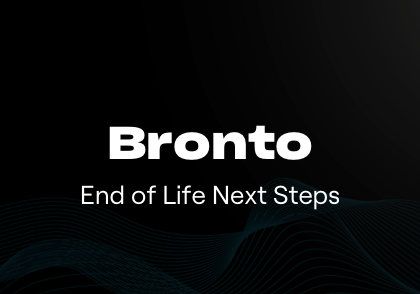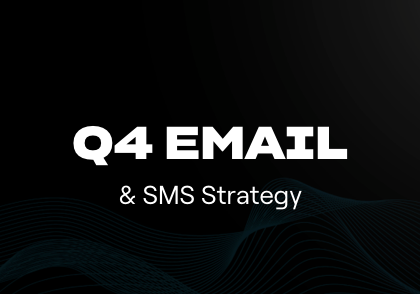In the world of ecommerce and direct-to-consumer, post-purchase email and SMS marketing flows have become increasingly important in order to maximize profitability and make the most of every customer you acquire.
These flows are an effective way to engage with customers and build relationships, while also driving revenue and increasing customer loyalty. However, they’re frequently overlooked by brands and as a result, post purchase sequences are extremely under optimized.
In this article, we’ll take a closer look at the latest best practices of post-purchase email and SMS marketing flows your brand will need to succeed in the modern era of ecommerce and beyond.
Post purchase flows are a must. By staying in touch with customers after purchase through email and SMS, brands can stay top of mind and provide valuable information, offers, and incentives to encourage repeat purchases. With the right strategy, you can build stronger relationships with customers and increase the LTV of each customer.
There are several different types of post-purchase flows that ecommerce brands can use to engage with customers.
These include the following: Order Confirmation Flows, Shipping Notification Flows, Customer Thank You/Education Flows, Cross-Sell and Up-sell Flows, Discount Ladder Flows and Winback Flows.

Now that you’re up to speed on the entire post purchase customer email and SMS journey, keep reading to get the ultimate breakdown on each flow’s best practices and common mistakes to avoid.
Order Confirmation Email Strategy
Order confirmation emails are an essential part of the post-purchase experience. They confirm that the purchase was successful, set expectations, and build trust with customers.
Order confirmation emails are often some of the most neglected, yet they often have the highest open rates out of any single email campaign.
Most importantly, make sure they’re on-brand and optimized for mobile (and of course, dark mode).
Take your order confirmation email to the next level by sharing your brand story, cross-selling additional recommended products, or driving customers to social or a community if you have one.
Here are some best practices for Order Confirmation Emails:
- Ensure a clear sender name and subject line
- Include important order information and easy access to support
- Ensure design is on-brand and optimized across all devices
- Include additional information to cross-sell or build brand
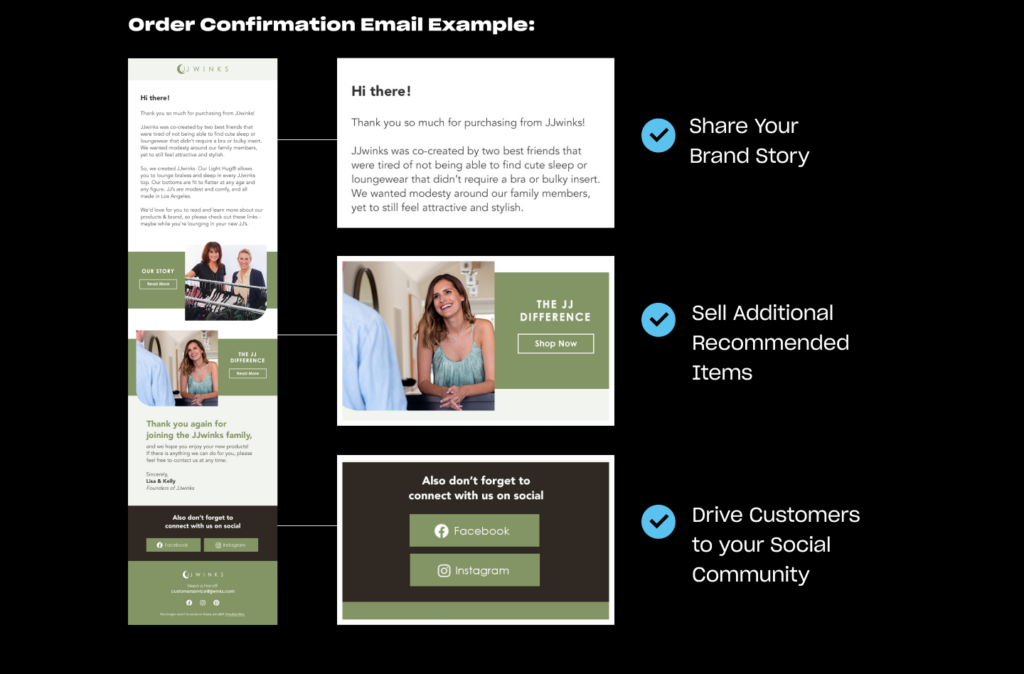
Should you send an Order Confirmation SMS?
Sending an order confirmation SMS is ultimately your brand’s preference. We typically don’t recommend it for clients because email offers a better customer experience for receipts and is also more cost effective for brands.
Shipping Notification Flow Strategy
After you send your order confirmation email, the next step in the post purchase customer journey is the shipping notification(s). While proactive shipping notifications used to be a way to stand out from the competition, today they have become table stakes.
Your Shipping Notification Flow is a key customer touchpoint that allows customers to track their order in real-time, building trust and increasing confidence in your brand and their purchase.
Just like your order confirmation email, your shipping notification emails should be on-brand and nicely designed because they are a key touchpoint with your customers that can make or break retention later on.
You should send a series of shipping notifications if possible for each stage of the shipping journey from initial shipment to out for delivery to delivered.
If you’re a luxury brand with higher AOV products or sell a product like furniture where delivery needs to be coordinated, you should have your shipping notification sequence dialed-in even more so than the average brand.
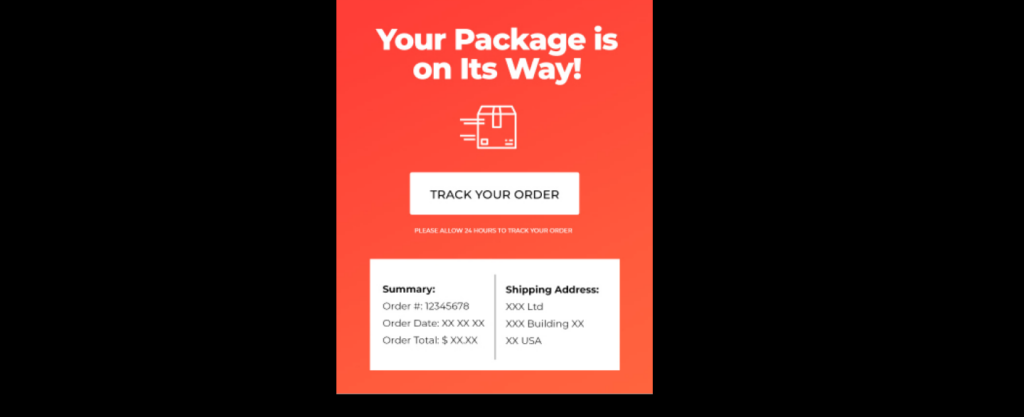
Should you send a Shipping Notification SMS campaigns?
If your tech stack allows, we absolutely recommend sending Shipping Notifications via SMS. This provides the best customer experience for customers and gets them used to hearing from you via SMS marketing.
Customer Thank You/Education Flows
Customer thank you/education emails and SMS messages are essential in ensuring customer satisfaction and building brand loyalty.
These flows are very straightforward. They provide an excellent opportunity to educate your customers on how to use your products to maximize retention.
When you show your customers that you care about their satisfaction and success, they are more likely to become repeat customers and recommend your brand to others.
Use this opportunity to educate your customers on how to use your product or service effectively. Provide clear instructions, tips, and best practices to ensure the best results. It helps to include video content if you have it. We’ve even included links to Instagram Reels or TikToks to help educate customers.

Review Flows: How To Generate More Reviews
At some point after purchase, you need to ask for reviews. By choosing the right timing, design, and implementing SMS you can maximize the amount of reviews you collect.
When is the best time to send a review request email?
Timing is key when it comes to collecting reviews. Consider your product or service and how long it takes for customers to see results. Once they’ve had enough time to use it, that’s when you should ask for their feedback.
Double Your Reviews with this Design Secret
The easier you make it for customers to leave a review, the more likely they are to do so. That’s where tools like Yotpo and Okendo come in. With certain review software, customers can leave a review and star rating directly in the email itself. No clicking through to a separate page required.
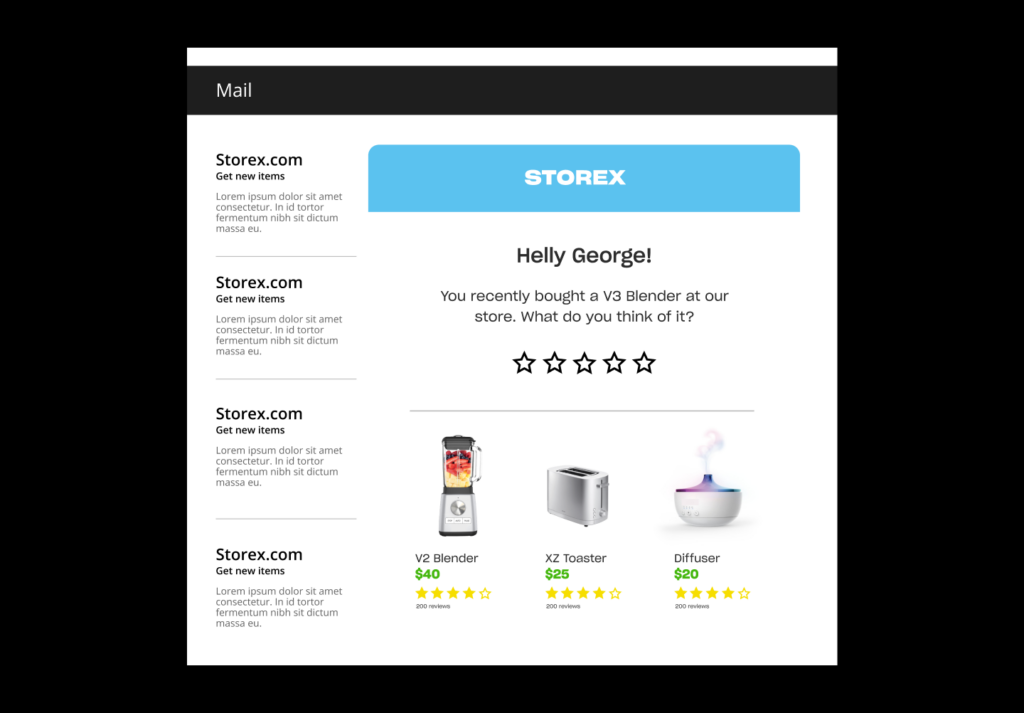
Leverage the Power of SMS
SMS is a powerful tool for collecting reviews. It has higher open rates and engagement than email, making it a great way to reach customers and get more reviews.
Cross-Selling and Upselling Flows
Cross-selling and up-selling are two essential strategies that help brands maximize revenue while enhancing customer satisfaction. It’s a win-win.
Email and SMS are the highest converting channels for cross-selling and up-selling products. These channels provide a cost-effective way to communicate with customers while delivering personalized offers and promotions.
The retention and cross-sell journey typically lasts from day 14 to day 90 after the initial purchase, but the real focus should be on the initial window from day 14 to day 60. After analyzing 100+ brands, it has been found that most customers lapse by day 60, and email engagement outside of super fans decreases significantly within that time frame. During days 14-30, the focus should be on full-price cross-sells, including similar products and tangential products
Depending on the brand, the “cross-sell” window can start anywhere from 7-14 days after purchase on the low end, to 20-60 days on the high end, depending on the product. Understanding when customers are typically re-ordering is key to developing an effective strategy.
To build a successful post-purchase strategy, it’s essential to use data to understand customer behavior and preferences. You can analyze purchase patterns to determine what the second purchase should be and how soon it can happen. The perfect cross-sell for every brand is going to be different. For some brands, the perfect cross-sell may actually be the exact same product.
Cross-selling and up-selling emails and SMS are effective strategies to increase revenue and enhance customer experience. By personalizing the offer, creating a clear and concise message, offering a compelling deal, and sending it at the right time, brands can encourage customers to make a repeat purchase.
Discount Ladder Flow
Starting from day 30, discounts can be offered. While there is a lot of talk about discounting impacting your brand negatively, it depends on a variety of factors. It is essential to understand the cost of acquiring a new customer and compare it to the cost of offering a discount to an existing customer. You can also use a discount ladder, starting with a 1-week sale at 10% off, then the next week 15% off, and so on, to encourage customers to convert without giving them a bigger discount.
Benefits of using a discount ladder:
- Get customers to make a purchase they wouldn’t have made
- Increased urgency since each offer will have a time limit
- Your brand maximizes profit by saving the highest discount for the least likely to convert customers
Discount Ladder Example:
- Days 30-40: 10% Off
- Days 41-50: 15% Off
- Days 51-60: 20% Off
Discount ladder emails/SMS can be a powerful tool for increasing sales and retaining customers. By gradually increasing the discount over time, you increase the customer’s incentive to purchase.

Non-Discount Promotion Ideas
Discounts may be effective for some, but they’re not always the right choice for every brand. Whether it’s a strategic choice to maintain pricing integrity or simply not financially feasible, there are still ways to offer value to customers without relying on discounts.
Gift with Purchase: This can be a small item, like a sample of another product or a branded tote bag, or a more substantial item, like a full-sized product. The key is to make sure the gift is relevant to the customer’s purchase and adds value to their experience with the brand.
Free Shipping: Shipping costs can often be a deterrent for customers, especially if they’re only purchasing one or two items. By offering free shipping, customers feel like they’re getting a better deal, even if the price of the product itself isn’t discounted.
Bundles: By combining products and offering a discounted price when purchased together, customers feel like they’re getting a deal. This is especially effective for products that are frequently purchased together, like shampoo and conditioner or skincare products that work well together.
Win-back Flows: Winning Back Customers Before They’re Gone
You’ve read this far and the customer STILL hasn’t purchased? You need a best-in-class win-back flow.
It is much less costly to re-engage an inactive customer than it is to acquire a new one, so don’t be afraid to be aggressive with your win-back strategy.
A win-back flow aims to bring back customers who have not made a purchase in a certain amount of time, usually between 45-60 days. Some brands are way too slow with their win-back efforts, waiting until day 90 or day 180 or even longer to attempt a win-back.
Components of an effective win-back email/SMS strategy
Timing: Around day 45-60 is when the “win-back window” kicks in for most brands. Analyze your data to determine when it makes sense to be more aggressive with your win-back strategy.
Strong subject lines: Your subject line needs to be compelling enough to get the customer to open the email/SMS. Use personalization, questions, and urgency to create a sense of importance.
Offers: To entice customers to come back, you need to offer them something of value. Consider offering your most aggressive discounts, free shipping, or gift with purchase. The offer should be communicated clearly in the email/SMS and have an expiration date to create a sense of urgency.
Email Creative: Use visuals and copy that align with your brand and message. Highlight the benefits of your product or service and what the customer is missing out on by not purchasing from you.
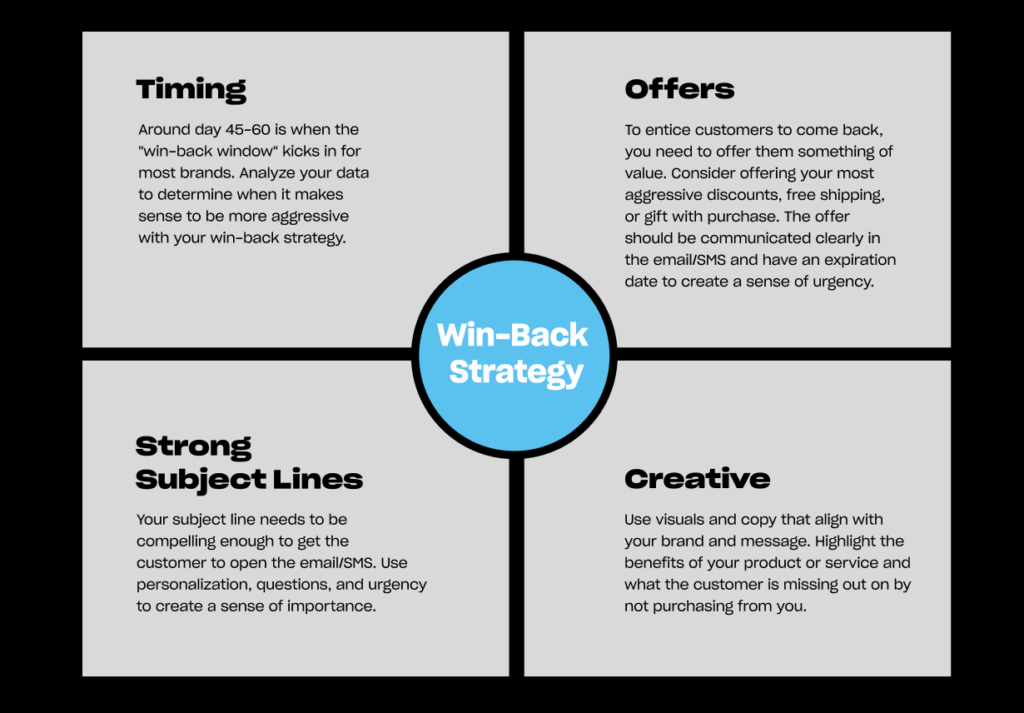
Examples of win-back emails/SMS offers and subject lines
Here are a few examples of win-back emails/SMS that use the components discussed above:
Example 1: Subject line – “We Miss You!” Offer – 30% off next purchase. Creative – Highlighting new products and the benefits of being a loyal customer.
Example 2: Subject line – “Don’t Let This Offer Expire!” Offer – Free shipping on next purchase. Creative – Use of urgency and highlighting the convenience of online shopping.
Example 3: Subject line – “Last Chance to Save!” Offer – $10 off next purchase. Creative – Use of urgency and highlighting the customer’s previous purchase history.
By understanding the timing, using strong subject lines, creating compelling offers, and using creative visuals and copy, you can win back lost customers and increase loyalty and advocacy for your brand.
Recommended Next Steps
Post-purchase email and SMS marketing flows are an essential aspect of any ecommerce business. These flows allow brands to establish a connection with their customers, boost customer loyalty, and increase revenue. With the right approach, post-purchase marketing can help brands to win back lost customers, cross-sell and up-sell products, and offer personalized discounts.
To implement effective post-purchase marketing flows, brands should consider the timing of the flow, as well as the design and content of the emails and SMS messages. It is also important to analyze customer data to understand their behaviors and preferences. By doing so, brands can tailor their post-purchase flows to maximize engagement and revenue.
Ready to retain more customers with email and SMS marketing? Let Wavebreak, the top email and SMS marketing agency, help you optimize your retention flows and increase your revenue. Contact us now to start building long-lasting customer relationships with best-in-class email and SMS marketing.

